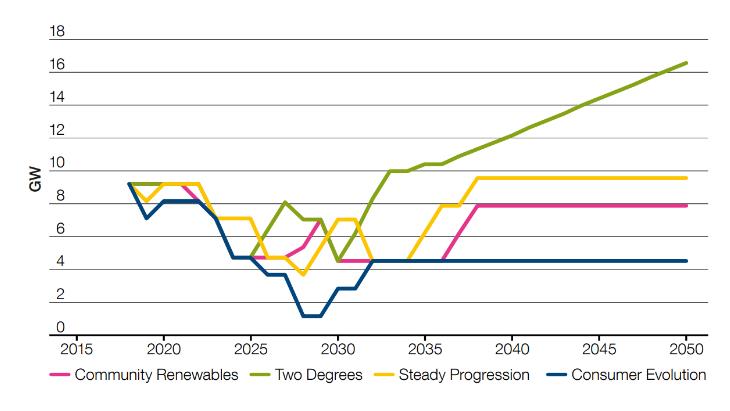Uncertainty over new nuclear project delivery has led the National Grid to develop new future energy scenarios, with lower projections of nuclear capacity additions between 2025 and 2040. In addition, only one of the four scenarios, the Two Degrees scenario, sees any nuclear capacity additions between 2040 and 2050.
The Two Degrees scenario has the highest eventual nuclear capacity, reaching 16.6 GW by 2050. This includes the addition of around 7 GW from small modular reactors (SMRs) from the early 2030s. The Steady Progression scenario would see nuclear capacity reach 9.6 GW by 2038, but grow no further, and with no SMR deployment. The Community Renewables scenario would see 7.9 GW of nuclear capacity by 2038, with the lowest nuclear capacity, 4.6 GWe, being in the Consumer Evolution scenario. This last scenario is consistent with only Hinkley Point C and Sizewell B being in operation beyond the early 2030s.
More nuclear needed to meet net-zero targets
The National Grid's report says that, to achieve the UK's new legally binding target of net-zero carbon emissions by 2050, the electricity system would need to operate using only zero-carbon generation and the power sector would need to deliver negative emissions. All four core scenarios fail to meet these goals. The Two Degrees scenario comes closest, "thanks to the high growth of renewable generation, nuclear capacity and interconnection as well as the use of carbon capture usage and storage (CCUS) with gas-fired generation". In the Two Degrees Scenario, by 2050, the power sector is projected to emit fewer than seven megatonnes of carbon dioxide equivalent per year, compared to about 73 megatonnes in 2017.
A separate net-zero scenario outlines the additional steps required for the UK to meet its new legally binding target. In this scenario electrification is greater than in any of the four core scenarios, mainly owing to greater electrification of the industrial and commercial sector. Consequently, peak electricity demand is much higher. Nuclear capacity is higher in the net-zero scenario, with installed capacity reaching 18.6 GW by 2050.
Tom Greatrex, CEO of the UK Nuclear Industry Association, said: "National Grid’s scenarios show the pathways to reach net-zero include a highly substantive role for new nuclear by 2050, even with a meaningful contribution from Carbon Capture, Usage and Storage, and continued growth of renewables. It also demonstrates nuclear’s share of the mix will dwindle without further nuclear investment in projects beyond Hinkley Point C. The planned Energy White Paper and consultation on a new nuclear financing model is a perfect opportunity to tackle this and make real strides towards a wholly clean electricity mix"
Consistent message
The report, which is based on input from over 600 experts, maps out “credible pathways and scenarios for the future of energy” for the next 30 years and beyond. It looks at the energy needed in Britain, across electricity and gas - examining where it could come from, how it needs to change and what this means for consumers, society and the energy system itself.
Fintan Slye, director of the Electricity System Operator at National Grid, says in the report that decarbonising energy is "fundamental in the transition towards a sustainable future". He adds: "Our Future Energy Scenarios aim to stimulate debate to inform the decisions that will help move us towards achieving carbon reduction targets and, ultimately, shape the energy system of the future."
The analysis concurs with a report published yesterday by the Committee on Climate Change, which says action to cut greenhouse gases is lagging far behind what is needed, even before the government set the tougher new target to cut pollution to zero overall by 2050.
In May, the UK - which is expected to host the 2020 UN climate change summit - became the first major economy in the world to pass laws to end its contribution to global warming by 2050.





_18570.jpg)
_18938.jpg)
_33584.jpg)
_82983.jpg)





